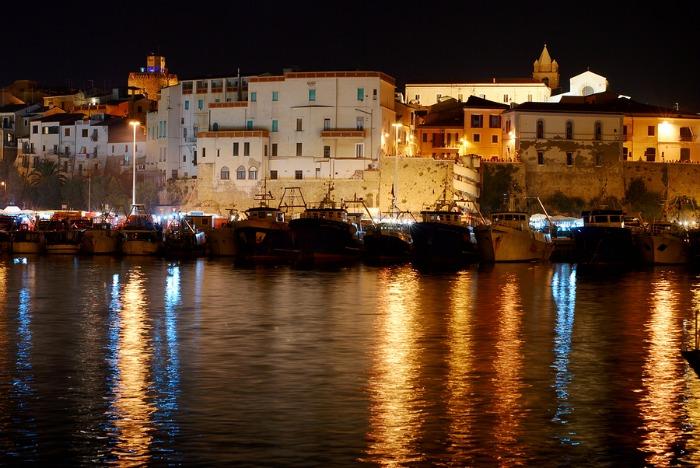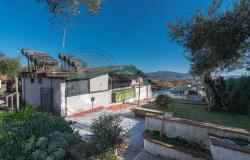Molise’s only port and major tourist resort, Termoli is a city dear to both its inhabitants and visitors for the unique atmosphere of its old centre, its nautical flavour and – not least – its bathing beaches.
In the narrow streets of the old town, with its small colour-washed houses and ancient palazzi in light stone, basking in the warm sun, the air is redolent of the sea.
But Termoli has many faces: within its walls a vibrant nightlife coexists with echoes of the city’s maritime tradition, still reflected today in many festivals and events.
The visitor’s first impression is of ochre and blue: the sand and the sea, the ancient fortifications and the clear sky. In the shadow of its Hohenstaufen fortress, which marks the entrance to the old town, palm trees and exotic plants thrive.
Water, Water Everywhere
 This is the only spot where the promontory on which the city is built meets the mainland. From here on, Termoli is surrounded by water. It takes only a few minutes to cross the city. The main road runs along its perimeter like a balcony overlooking the sea.
This is the only spot where the promontory on which the city is built meets the mainland. From here on, Termoli is surrounded by water. It takes only a few minutes to cross the city. The main road runs along its perimeter like a balcony overlooking the sea.
Even when venturing into the maze of narrow streets, the sea is always visible, through an arch or round the corner of a building.
The heart of the city beats around piazza del Duomo, with the Cathedral of San Basso. This impressive building is the hub around which the life of the city revolves: on fine days people meet on the white steps to have a chat and a drink and in the lazy afternoon hours children come here to play.
 A short walk to the north of the old town are the bathing beaches. As early as April, on fine days it is warm enough to tempt you to strip off and have a swim. But the sea is not Termoli’s only attraction. Behind the city, there are gentle hills clothed in olive groves, vineyards and orchards.
A short walk to the north of the old town are the bathing beaches. As early as April, on fine days it is warm enough to tempt you to strip off and have a swim. But the sea is not Termoli’s only attraction. Behind the city, there are gentle hills clothed in olive groves, vineyards and orchards.
This is one of Molise’s most fertile areas, producing the region’s finest wines and oil. Among these hills nestle villages, such as Guglionesi, huddled round the church belltower, with beautiful views, Larino with its amphitheatre and Guardialfiera, overlooking a lake crossed by a viaduct.
The streets are nearly always silent and you are more likely to come across boys on an ox-cart than a car. Well, to be honest this is quite unusual, but glimpses of an older Italy are not that rare.
On The Road to Campobasso
 Leaving Termoli and taking the road which skirts the River Biferno, it is possible to cross the whole of Molise in less than a day. Before reaching Campobasso, the regional capital, at the foot of the Matese massif which marks the border with Campania, you come across the small town of Ripamolisani.
Leaving Termoli and taking the road which skirts the River Biferno, it is possible to cross the whole of Molise in less than a day. Before reaching Campobasso, the regional capital, at the foot of the Matese massif which marks the border with Campania, you come across the small town of Ripamolisani.
At its highest point, near the church, the town’s ancient fortress has been converted – half into housing and half into a luxury hotel (with even a chapel to host weddings). The town is very compact, but well worth visiting for its many stone arches, its streets paved with cobbles known as sanpietrini, its constant climbs and descents and the wonderful views over the Biferno valley.
There is a danger of arriving at Campobasso with preconceived notions of the city’s lack of attractions, but there is a central square (Piazza Pepe) in Neo-Classical style with a cathedral resembling an ancient temple and its main streets, clean and elegant, are crowded with people heading for somewhere to spend a pleasant evening. Quiet, narrow streets lead from the city’s spacious 19th-century quarter into the earlier medieval heart at the top of the hill, overlooking the new city. A stiff uphill climb leads first to the Church of San Bartolomeo and the Church of San Giorgio, built in 1099, and finally to the Monforte Castle, symbol of the city. This small regional capital is home to lively, friendly people and there is no shortage of good restaurants and pizzerie.
Quiet, narrow streets lead from the city’s spacious 19th-century quarter into the earlier medieval heart at the top of the hill, overlooking the new city. A stiff uphill climb leads first to the Church of San Bartolomeo and the Church of San Giorgio, built in 1099, and finally to the Monforte Castle, symbol of the city. This small regional capital is home to lively, friendly people and there is no shortage of good restaurants and pizzerie.
Between Campobasso and the Matese massif the atmosphere is very much as it was a century ago: well off the traditional tourist trail, villages as Bojano, Monteroduni and Vinchiaturo have the feel of unexplored, virgin territory.
Things are very different at the ruins of Altilia Sepino, a mecca for tourists and history enthusiasts. It is an exciting experience to walk along a cardo or decumanus, to pass close to the columns of the forum or the fountains in front of the temples to pagan divinities, to visit the theatre, the town gates and the medieval houses built from materials taken from the earlier structures.
The Matese is the perfect place for those in search of peace and tranquillity, with its glimpses of the picture-postcard Italy. The cuisine here perhaps lacks the subtlety of seafood but contains simple dishes and many varieties of cheese and cured meats or pasta dishes with rich sauces… delicious!





